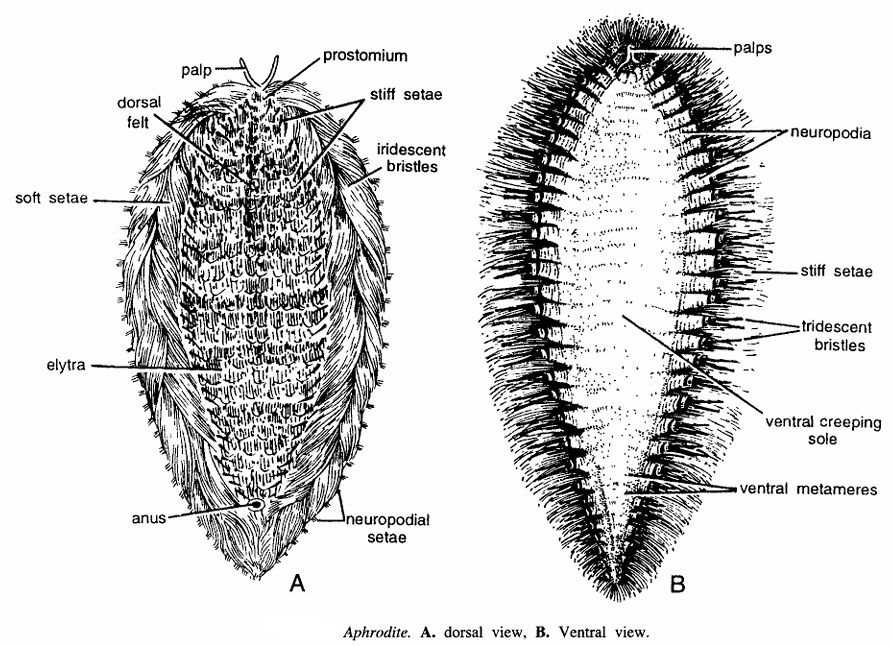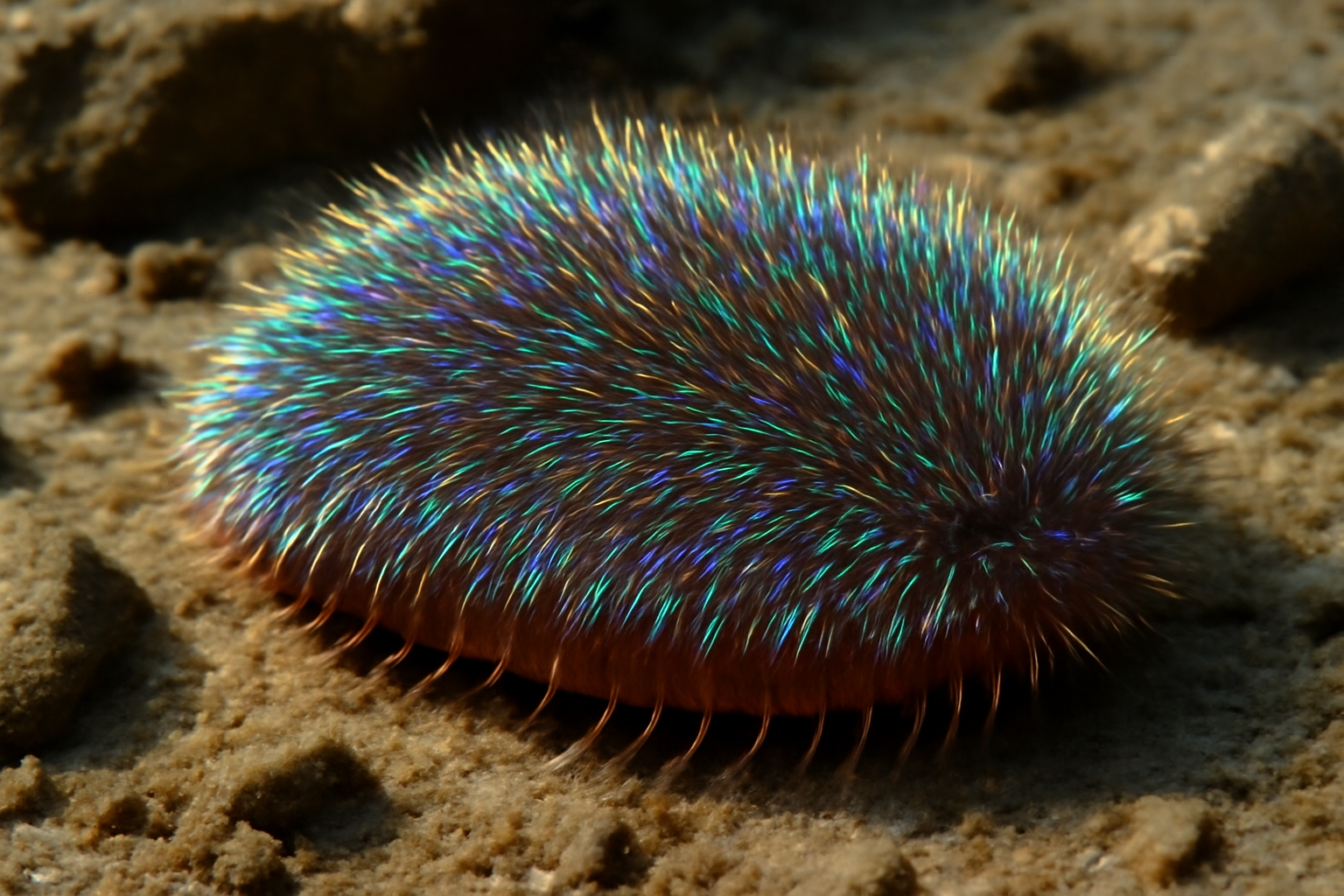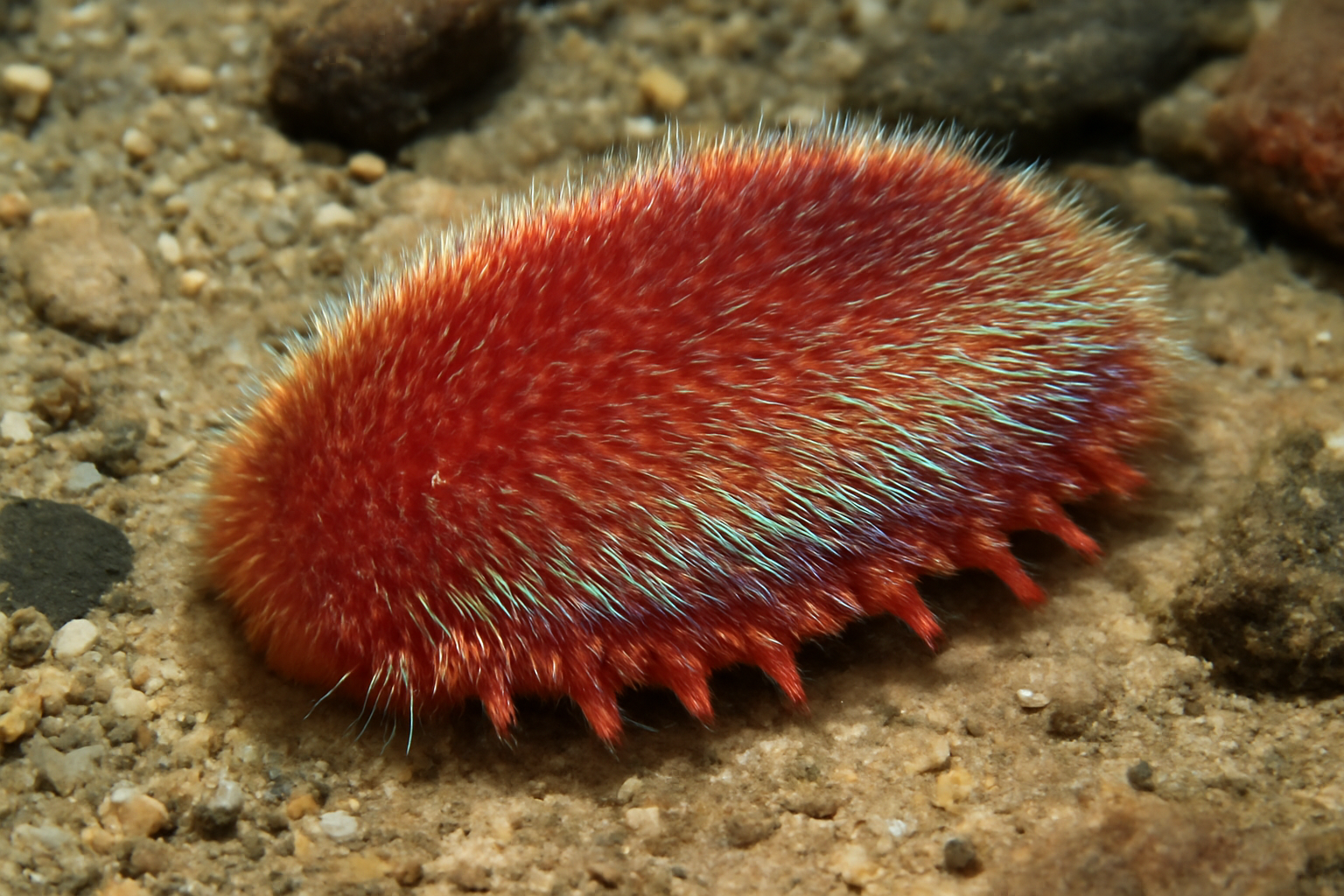Aphrodite: The Sea Mouse – Morphology, Classification, Habitat, and Ecological Significance
Aphrodite, commonly known as the “sea mouse,” is a genus of marine polychaete worms belonging to the family Aphroditidae. These fascinating annelids are named after the Greek goddess of love because of their delicate, iridescent appearance reminiscent of fine fur or the softness associated with Aphrodite’s domain. The sea mouse is notable for its flattened, oval body covered with dense bristles (setae) that shimmer with iridescent colors when light strikes them. Found often buried in muddy or sandy seabed sediments, Aphrodite species play varied ecological roles as scavengers and detritivores in marine environments. Their remarkable structural coloration and unique body features have attracted substantial scientific interest.
Classification of Aphrodite
| Taxonomic Rank | Name | Characteristics |
|---|---|---|
| Kingdom | Animalia | Multicellular, eukaryotic organisms |
| Phylum | Annelida | Segmented coelomate worms with metameric body structures |
| Class | Polychaeta | Marine bristle worms with paired parapodia |
| Order | Phyllodocida | Free-moving polychaetes with sensory appendages |
| Family | Aphroditidae | Polychaetes with elytra (scales) and dense iridescent setae |
| Genus | Aphrodite | Sea mice with oval, flattened bodies covered in iridescent bristles |

Habit and Habitat
Aphrodite species primarily inhabit subtidal to deep-sea benthic zones, preferring muddy or sandy substrates where they can burrow or remain partially buried. They are generally found just below low-tide levels to depths exceeding 1000 meters. This benthic lifestyle helps them scavenge dead organic matter and small invertebrates, contributing to sediment nutrient cycling. Often, sea mice are discovered washed ashore after storms, revealing their burrowing behavior and oceanic distribution.
Geographical Distribution
The sea mouse is cosmopolitan in distribution, found in the Atlantic Ocean, Mediterranean Sea, North Sea, Baltic Sea, and parts of the Pacific Ocean. Different species inhabit temperate, tropical, and even cold waters, adapting to a variety of oceanic environments. Their wide range is enabled by a planktonic larval stage that disperses widely before settling into benthic habitats.
General Characteristics
- Commonly called as sea mouse measuring approximately 12 cm in length and made up of 30 to 35 segments.
- Body is covered dorsally by felt-like or blanket-like setae arising from the notopodium.
- Shape of the animal is oval, and dorsoventrally flattened.
- The dorsal surface is convex and is covered with setae of different kinds.
- Anterior end contains a small head or prostomium, bearing a small median tentacle and 2 lateral palps.
- Anus is dorsally situated at the more pointed posterior extremity.
- Parapodial structures are greatly modified. Notopodia contain 3 kinds of setae-(i) stiff setae, (ii) soft setae, and (iii) iridescent setae. Neuropodial setae are also brown and stiff.
- The soft notopodial setae are modified to form a felt-like covering over the back of the animal, while dorsal cirri become plate-like and are called as elytra, 15 pairs in number. The elytra obtain dissolved oxygen from the sea water circulating around them.
- Ventral surface is flat, segmented and forming a creeping sole. Each ventral segment or metamere contains stiff setae.
- Pumping action of the dorsal body wall causes the sea water to be filtered through the dorsal felt into the space below.
- Body Shape and Size: Oval, somewhat flattened dorsoventrally, typically measuring 7.5 to 15 centimeters in length, with some individuals reaching up to 30 centimeters.
- Elytra (Scales): The back is covered by a pair of rows of shield-like elytra that provide protection and support.
- Setae: Dense mats of hairlike setae cover the elytra, often long and soft, forming a felt-like blanket. These bristles exhibit iridescence, shining green, blue, or golden when light hits them perpendicularly.
- Coloration: Primarily red or reddish-brown with iridescent bristles influencing color appearance.
- Head: Lacks eyes, but bears two pairs of appendages close to the mouth used for sensory detection.
- Locomotion: Uses many small paddle-like parapodia bearing setae for creeping and burrowing activities.
- Hermaphroditism: Individuals possess both male and female reproductive organs; fertilization requires interaction between sperm and eggs of different individuals.

Special Features
- Structural Coloration: The iridescent effect of the bristles arises from photonic structures made of hexagonal cylinders within the setae, acting like natural optical fibers. This provides camouflage and possibly predator deterrence.
- Protective Elytra: The elytra not only protect but also play roles in respiration and sensory perception.
- Defense Mechanism: When threatened, the sea mouse can roll into a ball and erect stiff chaetae acting like spines for defense.
- Burrowing and Feeding: Soft setae allow efficient substrate movement, while the bristles decouple to trap sediment particles during locomotion.
- Commensal Relationships: Hosting various small organisms such as entoprocts beneath their scales has been documented, showing ecological interdependencies.
- Musculature and Movement: The specialized musculature supports a fast stepping form of locomotion differing from usual sinusoidal worm movements, adapted for their habitat and lifestyle.
Identification
Identifying Aphrodite species involves:
- Examining elytra size, shape, and patterning.
- Observing the length, arrangement, and iridescence of the setae.
- Checking parapodial structures including dorsal notopodia and ventral neuropodia.
- Noting presence of stiff defensive chaetae amid softer bristles.
- Studying reproductive features and larval development.
- Morphological comparison aided by behavioral observations.

Life Cycle and Reproduction
Sea mice reproduce sexually with external fertilization. Hermaphroditic individuals exchange gametes with others during spawning. Following fertilization, larvae undergo a planktonic trochophore stage before settling to the seabed to develop into juvenile worms. Growth continues until adulthood, which can take several months.
Their life cycle is closely tied to environmental conditions, ensuring population resilience and genetic diversity. Aphrodite species do not migrate extensively but remain largely benthic, except for their larval dispersal phase, which aids colonization of new habitats.
Ecological Role and Importance
- Detritivore: Plays essential roles in breaking down dead organic matter and cycling nutrients in marine sediments.
- Prey: Serves as a food source for fish and larger invertebrates.
- Bioindicator Species: Population density and health provide clues about sediment quality and ecosystem stability.
- Scientific Interest: Natural optical properties contribute to biomimicry research and photonics.
- Marine Biodiversity: Adds to benthic ecosystem complexity and interspecies interactions through commensalism.
Check sources
- https://en.wikipedia.org/wiki/Aphrodita
- https://www.marlin.ac.uk/species/detail/1697
- https://www.britannica.com/animal/sea-mouse
- https://www.biologydiscussion.com/structures/structure-of-sea-mouse-aphrodite-zoology/60628
- https://zslpublications.onlinelibrary.wiley.com/doi/abs/10.1111/j.1469-7998.1971.tb04546.x
- https://en.wikipedia.org/wiki/Aphrodita_aculeata
- https://www.ebsco.com/research-starters/zoology/sea-mouse
- https://animaldiversity.org/accounts/Speyeria_aphrodite/
- https://www.tandfonline.com/doi/full/10.1080/11250003.2012.758783
- http://invertebratezoologycollection.weebly.com/aphrodita-aculeata.html
- https://www.sciencedirect.com/science/article/pii/S1439609204700379
- https://sealifebase.se/summary/Aphrodita-aculeata.html
- https://www.vedantu.com/question-answer/aphrodita-commonly-known-as-sea-mouse-is-aan-a-class-11-biology-cbse-5f67fc1bb12a162d4ff4ed77
- https://animaldiversity.org/accounts/Tosanoides_aphrodite/
- https://www.vedantu.com/question-answer/aphrodite-commonly-known-as-sea-mouse-is-an-a-class-12-biology-cbse-5f5a75216e663a29cc0782fe
- http://www.marinespecies.org/aphia.php?p=taxdetails&id=129840
- https://www.embibe.com/questions/Aphrodite,-commonly-known-as-sea-mouse-is-a:/EM7283423
- https://biotic.marlin.ac.uk/data/species/4405
